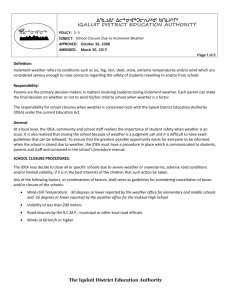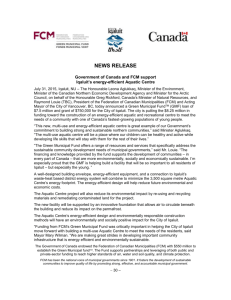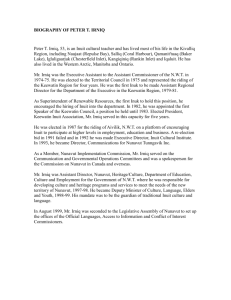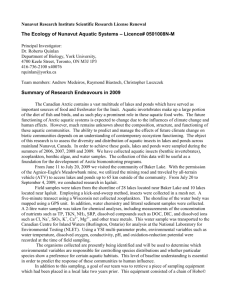Iqaluit
advertisement
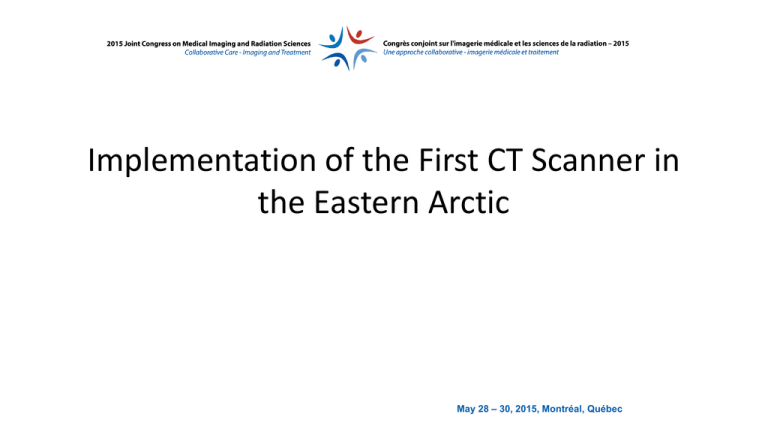
Implementation of the First CT Scanner in the Eastern Arctic May 28 – 30, 2015, Montréal, Québec Disclosure Statement: No Conflict of Interest I do not have an affiliation, financial or otherwise, with a pharmaceutical company, medical device or communications organization. I have no conflicts of interest to disclose ( i.e. no industry funding received or other commercial relationships). I have no financial relationship or advisory role with pharmaceutical or device-making companies, or CME provider. I will be discussing the results of ____ (“off-label” use), which is currently classified by Health Canada as investigational for the intended use. I will not discuss or describe in my presentation at the meeting the investigational or unlabeled ("off-label") use of a medical device, product, or pharmaceutical that is classified by Health Canada as investigational for the intended use. May 28 – 30, 2015, Montréal, Québec Implementation of the First CT Scanner in the Eastern Arctic PRESENTED BY: JENNIFER SHARPE MANAGER OF DIAGNOSTIC IMAGING, QIKIQTANI GENERAL HOSPITAL Iqaluit, Nunavut Iqaluit - ᐃᖃᓗᐃᑦ - 'Place of many fish' City of Iqaluit is located on Baffin Island, at the northern end of Frobisher Bay, near the mouth of the Sylvia Grinnell River. Iqaluit is the territorial capital of Nunavut, the largest and fastestgrowing community in the territory. The landing strip is long enough to land the space shuttle, so it is often used for cold weather testing of the world's largest new aircraft. Formerly known as Frobisher Bay, the modern city of Iqaluit is rich with traditional Inuit culture. The friendly people of Iqaluit — the 'Iqalumiut' — love to go out on the land, sea and ice at all times of the year to enjoy a variety of outdoor activities. Iqaluit, Nunavut Iqaluit - ᐃᖃᓗᐃᑦ - 'Place of many fish' POPULATION 7,250 60% Inuit Languages – Inuktitut, English, French From May through August, days are long and sunny, averaging 16 hours of daylight with temperatures of 5°C to 25°C. The city enjoys nearly 24 hours of sunshine in late June and early July, with beautiful twilight skies for two hours around midnight. The shortest days of December have four hours of daylight, with the sun hovering on the southern horizon. Northern Lights are frequently seen from October to April. Winter temperatures of -10°C to -50°C are common. Where the heck is Iqaluit, anyway? Qikiqtani General Hospital QGH is a 35 bed acute care facility in Iqaluit. The hospital serves the approximately 16,000 people in the Qikiqtani (Baffin) Region, which is home to 12 communities spread over approximately one million square miles! It is the only hospital located in the territory of Nunavut. Relevant Statistics Lung cancer is the leading cancer amongst Nunavummiut, accounting for 32% (247cases) of reported cancer cases. 60% of Nunavummiut aged12 years or older report smoking, which is three times higher than the national average. 62 % of Nunavummiut diagnosed with lung cancer died within one year of diagnosis. A CT scan can reveal small lesions in the lungs that might not be detected on an X-ray. Colorectal Cancer is the second leading cancer in Nunavut, accounting for 19% (136 cases) of reported cancer cases. Risk factors include alcohol and tobacco use, diet and obesity. 26% of Nunavummiut who were diagnosed with colorectal cancer died within one year of diagnosis. Relevant Statistics Since its inception as a Territory in 1999, Nunavut has faced the highest reported tuberculosis (TB)incidence rate in Canada. The rate of TB infections in Nunavut is 62 times the Canadian average. Crowded housing conditions, poor nutrition and high smoking rates partly contribute to the high rate of TB incidents. TB primarily attacks the lungs and can be deadly without treatment. HRCT scanning in the investigation of TB may be helpful in differentiating active TB from LTBI more reliably. Lung mass is not visible on conventional X-rays unless they are larger than 5-6 mm in diameter. Modern CT machines can detect lesions up to 1-2 mm in diameter. CT is more sensitive than chest radiography and can accurately detect tumor site, size and invasion to adjoining structures such as mediastinum, chest wall, etc. Referrals South Transportation by scheduled commercial airline for elective referrals ($1400 approx. cost of return flight to Ottawa). Approx. Duration of stay for patients transported to Ottawa averaged 12.8 days ($2600 approx. cost for accommodation and expenses for this duration). Length of stay is due to wait times for diagnostic work-ups prior to specialist visits or scheduled appointments being cancelled. Standard process allowed 3 to 4 days between diagnostic testing and clinic visit to ensure results are available before seeing specialist. Medevac for emergent cases, service includes physician or nursing escort as appropriate ($25,000 approx. cost for flight and crew PER RETURN FLIGHT!) Over 400 patients were flown south for CT examinations in 2010. Approx. 11% of these were medevac patients due to trauma. About 50 transports were for scans to rule out head and neck injuries. Impact on Patients Wait times were often 3-4 months for a CT, despite preferential treatment by Ottawa for Iqaluit patients. Physicians related situations where wait times for CT diagnostics were so long that the patients’ conditions moved beyond treatment. Extended stays (up to 12 days) in Ottawa can cause anxiety for residents of the Baffin Region as many are unfamiliar with or do not speak English. Patients from communities have to first travel to Iqaluit and then on to Ottawa (depending on which community, flights to Iqaluit can be anywhere from 2-5 hours). Have to travel alone or with one escort depending on severity of symptoms. Coroner’s Inquest Reiterates Need for CT Machine in Iqaluit Elisapee Michael, 52, fell head-first down the stairs outside the Nova Inn on Aug. 9, 2009. Police put Michael in a cell where, hours later, they discovered that she was unresponsive. Michael was then medevaced to Ottawa, where she died Aug. 13 from her head injury. If CT was available at the time, injury could have possibly been diagnosed sooner. Challenges Around Implementation of CT Only possible if a PACS is in place so that radiologists can effectively guide its operation and promptly interpret CT studies. Web presentation is limited by Government of Nunavut’s (GN) bandwitdh; GN network must be upgraded. Network is run on Satellite, which slows transmission times and limits amount of traffic. No Radiologist on site. Inappropriate to expect family physicians to conduct even preliminary interpretations on CT exams due to breadth of pathologies for which CT is applicable and unique orientation of images. Staffing: recruitment and retention of CT technologists may prove difficult. Geographic location! Benefits Patients More accurate diagnosis Shorter wait times, particularly for elective Reduced travel (fewer trips and shorter duration of stay) Physicians Increased confidence in diagnosis Improved communications with Specialists Reduced dependency on inclement weather for emergency travel Ability to treat more local patients Service closer to home in familiar environment Improved diagnostic capabilities during clinic days Early diagnosis and improved outcomes Increased confidence in local health care Fewer lost work days due to medical travel Shorter turnaround time for Radiology reports (1 hour for Stat cases VS 3-4 days) Department of Health/QGH Platform to offer additional specialty clinics Improved public perception of Nunavut Health Services Possibility of attracting and retaining permanent physicians Early diagnosis leads to reduced administrative costs Reduced travel costs The Process Established new Radiology contract with The Ottawa Hospital (TOH) to incorporate PACS solution and increased availability of Radiology service. Network upgrades completed in 2013 to handle increased traffic on GN network and availability of increased transmission times for Iqaluit. Dedicated server to accommodate PACS integration. RFP generated to include provisions unique to geographic location, Turnkey Operation and White Glove Delivery. Workflow created to include community films (still wet processing) due to lack of Network infrastructure outside of Iqaluit. Job Shadowing with Rob Chatelain at Civic Campus of TOH to enhance understanding of overall functionality of CT program. And So It Begins… Construction for the renovations required to implement CT machine began in September 2013. All supplies, tools and equipment needed for renovations had to be flown up with the construction crew due to lack of availability in Iqaluit. When the hospital was built in 2007, considerations were already made in anticipation of acquiring a CT machine. Renovations to CT room and Control room were completed by early December 2013. As I headed to Milwaukee, WI to participate in training, the CT machine was being prepared for travel to Iqaluit. The Delivery The CT machine weighs approx. 10,000 lbs. Only possible way to deliver machine was by air cargo. Had to be flown up with 2 SCI passengers to ensure safe transportation of machine and all necessary equipment for installation. Transportation of CT machine alone was in excess of $50,000! QGH ambulance bay was used to receive machine and all of its parts. Provisions had to be made to ensure machine was kept at a constant temperature due to the risk of components freezing in our extreme cold environment! Installation was completed within 2 days of arrival. History is Made! Due to lack of on site Radiologist, the process of protocolling CT requests was not feasible for TOH to do. January, 2014 I spent a week in Ottawa training with a radiologist to learn how to protocol these requests. On February 2, 2014, the applications specialist was on site and the first ever CT scan was performed in Nunavut! At this point, PACS went live for Iqaluit, but was still not quite ready for integration with TOH PACS. CT examinations were burned to CDs and mailed to TOH for Radiologists to report. Final reports were then faxed back to DI department in Iqaluit for distribution to physicians. Photo: Qikqitani hospital acquires long-awaited CT scanner Excerpt from Nunatsiaq News, February 17, 2014 Jennifer Sharpe, manager of diagnostic imaging at Qikiqtani General Hospital in Iqaluit, operates the hospital’s new computed tomography, or "CT" scanner, Feb. 14. In operation since Feb. 3, the $2.1-million CT scanner helps medical staff make more accurate diagnoses and is expected to reduce patient wait-times, now that Nunavummiut do not have to travel south for the procedure, Nunavut’s health department says. The hospital will share records from the scans by April of this year with a hospital in Ottawa through a network connection. (PHOTO BY PETER VARGA) Nunavut’s first CT scanner starts service at Qikiqtani Hospital Qikiqtani General to link patient records with The Ottawa Hospital “They’re very comfortable to be able to come to their own hospital, and get the exam done, versus going to Ottawa, and having to find their way around three huge hospitals,” Sharpe said Feb. 14. “No one else in Canada operates a CT over a satellite network, and equipment vendors never had to deal with that before,” he said. “So you have to educate (them) as they come through. And when something like this works out, it’s absolutely impressive.” “It reduces some trips to Ottawa, for sure,” MacDonald said. “It’s $25,000 a medevac – that’s a lot of money. You would only have to save $2 million of those dollars to pay for the CT scanner.” PACS Goes Live With TOH April 2014, Nunavut and TOH PACS go live. Xrays and Ultrasounds have transmission of less than 5 minutes. CT Head: ~8 minutes CT Abdomen & Pelvis: ~20 minutes CT Lower Extremity Runoff: ~30 minutes Films from 12 communities in Baffin Region are sent to Iqaluit via air cargo, digitized, and sent to TOH through PACS. Significant increase in turn around time for reports – both in Iqaluit and communities. Remarkable increase in patient care, especially in Emergent Situations. Demographics CT Scans Since acquiring the CT machine in February 2014, QGH has completed 1750 CT examinations! Spine 11% Chest 24% Neck 3% Head 29% Facial 4% Extremities 4% Chest Neck Abdo/Pel. Abdo/Pel. 25% Extremities Facial Head Spine Only in Nunavut… Nunavut Polar Bear Attack Survivors Thankful to be Alive! a polar bear’s bite is 1,200 pounds per square inch; a shark has a psi of 669 and a Rottweiler dog, 328 “When it was biting my head, I could see inside its mouth. It was all black and smelly. I could see the tooth biting just beside my eye,” What The Physicians in Iqaluit Are Saying… “Having CT in Iqaluit has decreased our miss rate on potentially serious diagnosis, improved patient care, and easily paid for itself by saving costs on flights to Ottawa.” Dr.Greg Devet “Despite initial worry that we would be keeping sicker patients than we would have without a CT it has become an excellent resource which has taken much guess-work out of clinical care. My work is principally in outpatient care and CT has been invaluable in managing many cases where the diagnosis was suspect but not critical and would not warrant a trip to Ottawa. It is also sometimes an alternative to have access to when Ultrasound is delayed.” Dr.Alison McCallum References www.gov.nu.ca/health www.nunatsiaqonline.ca www.cbc.ca/north JRS Partners Inc. Martin Joy, Director IT, Government of Nunavut www.nunavuttourism.com/regions-communities/iqaluit Thank you to Rob Chatelain, OHRIA, Karina Burt, Imad AlChikie, Sandra Clark
